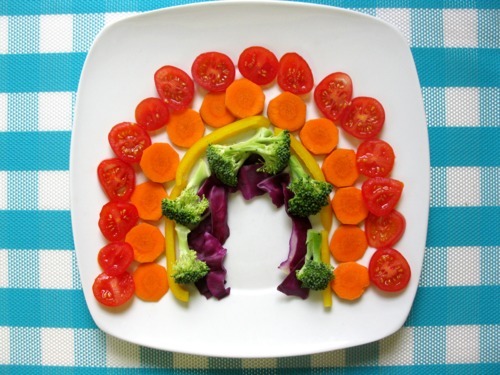CarrotsA cup of raw carrots contains a whopping 34317 IU of vitamin A, making it the richest vegetable source of pro-vitamin A carotenes, a phytonutrient which has shown to help protect vision and is associated with reduced risk of heart disease and certain types of cancers. This orange root crop is also a very good source of vitamins C and K, dietary fiber and potassium and a good source of B complex, manganese, molebdenum, phosphorus, magnesium and folate.TomatoesTomatoes are bursting with more than 20 vitamins and minerals. A cup of ripe red tomatoes supplies an excellent amount of vitamins A, C and K. It is a very good source of molebdenum , potassium, manganese, chromium and vitamins B1 and B6. It is also a good source of folate, copper, iron, B complex and other essential nutrients. Tomatoes are well known for their lycopene content, a phytonutrient with antioxidant and anti-cancer properties.Sweet PotatoesA cup of baked sweet potatoes with skin is an excellent source of vitamin A in the form of beta-carotene as it contains 13107 IU of this powerful antioxidant. It is also a very good source of manganese and vitamin C and a good source of vitamin B6 and the minerals copper, fiber, potassium and iron. Purple-fleshed sweet potatoes are rich in anthocyanins and have the highest antioxidant activity among sweet potato varieties.SoybeansSoybeans are one of the most well researched health-promoting foods in the world today. A cup of cooked soybeans can supply the body with excellent amount of molebdenum and tryptophan, a very good amount of manganese and protein and a good amount of more than 10 other essential nutrients including omega-3 fatty acids, fiber and potassium. One cup of soybean provides more than 50% of the daily value of protein.AsparagusThis almost leafless member of the lily family with fleshy green spears has been considered a delicacy since ancient times. A cup of boiled asparagus is an excellent source of vitamins A, C and K and folate. It is a very good source of more than 10 vitamins and minerals including B complex, potassium and fiber. Asparagus has been described by second century physician, Galen, as “cleansing and healing.”Bell PepperWith their beautifully shaped glossy exterior that comes in a wide variety of vivid colors ranging from green to black, bell peppers are known as the Christmas ornaments of the vegetables world. A cup of sliced, red, raw bell pepper provides 5244 mg of vitamin A which is more than 100% of DV. It is also an excellent source of vitamins C and B6 and a very good source of fiber, molebdenum, manganese and folate.SpinachSpinach is a treasure-trove of nutrients as it boasts more than 35 essential vitamins and minerals. A cup of boiled spinach is an excellent source of over a dozen nutrients. It can provide the body with three times the DV of vitamin A and over 1000% of the DV of vitamin K as it contains 1023 mcg of the nutrient. More than a dozen flavonoids has also been identified with this leafy green. Brussels SproutsA cup of boiled Brussels sprouts is an excellent source of vitamins C and K and a very good source of B complex, folate, fiber, potassium and vitamin A, one of the most important antioxidant found in nature. This miniature cabbage look-alike is also rich in vitamin E, calcium and copper. Studies have shown that diets high in cruciferous vegetables, such as Brussels sprouts, broccoli, cabbage and cauliflower are linked to lower incidence of certain cancers, including lung, colon, breast and ovarian cancer.BroccoliBroccoli has been considered a uniquely valuable food among Italians since the Roman Empire. A cup of boiled broccoli supplies an excellent amount of vitamins A, C and K, folate and fiber. It contains 505 mg of potassium and 102 mg of phosphorus. It is also rich in iron, zinc, vitamin E, B complex and over 20 other essential nutrients. Broccoli may be eaten raw, boiled or steamed, but steaming, microwaving and stir-frying are recommended so as not to read more..

No comments:
Post a Comment